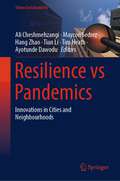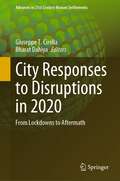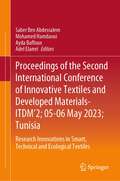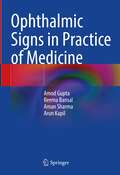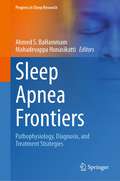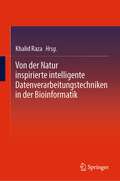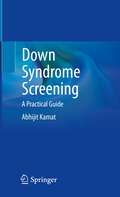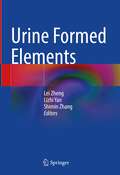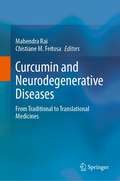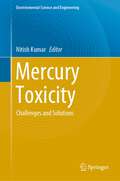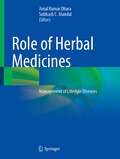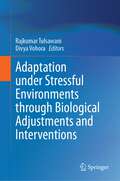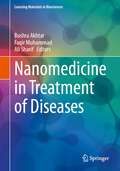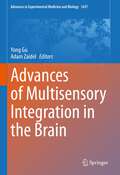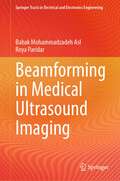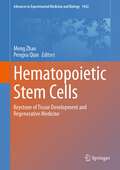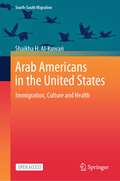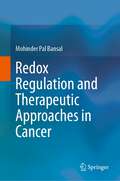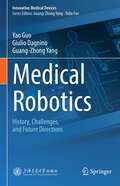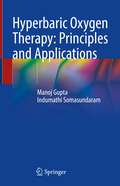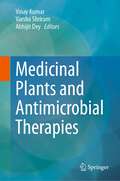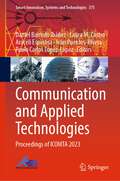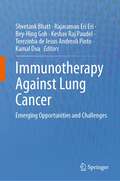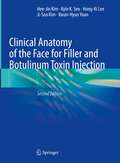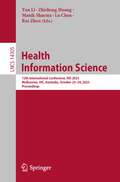- Table View
- List View
Resilience vs Pandemics: Innovations in Cities and Neighbourhoods (Urban Sustainability)
by Ali Cheshmehzangi Maycon Sedrez Hang Zhao Tian Li Tim Heath Ayotunde DawoduThe COVID-19 pandemic and other highly transmissible diseases outbreaks have given a new significance to the concept of “resilience”, placing it in the spotlight of built environment-related studies. New directions have emerged from expanding on adaptive planning, urban layouts, urban morphologies, spatial planning, healthy cities, etc. To enhance resilience in the post-pandemic era, various theories, practices, and hypotheses are being formulated by scholars around the world.For this book project, we invite chapter proposals that provide forefront discoveries about the built environment resilience during and after the ongoing pandemic. Historical perspectives of resilience and other highly transmissible diseases are also relevant to understanding the COVID-19 issues. The authors are encouraged to elaborate on critical exploratory, innovative, and cutting-edge research approaches, highlighting the effects of COVID-19 and other highly transmissible diseases in the design, planning, and perception of the built environment. We aim to gather scientific experiences, reviews, analyses, discussions, recommendations, and solutions in the fields of urban planning, urban design, urban management, environmental science, architecture, etc.The book aims to document resilience-related innovations and new perspectives for the built environment, how people’s interactions adapt to new realities, and which mechanisms, tools, and strategies are required for such transformations in the following two scales of the built environments:(1) City/district; research on planning, commuting and mobility, politics, urban configurations, regulations, transmission and prevention, models, top-down processes, innovation processes, etc.(2) Community/neighborhood; research on collaboration, transmission and prevention, isolation and quarantine, social aspects, accessibility to services, technologies, education, policies, and innovative solutions.The book covers a wide range of studies, including physical and non-physical studies, which may refer to the city infrastructure, green/blue spaces, housing, policy-making, health services, social and economic issues, etc. The findings and results contribute to the decision-making of governments, organizations, and institutions, as well as inspire scholars and future research for developing resilience in the post-pandemic era.
City Responses to Disruptions in 2020: From Lockdowns to Aftermath (Advances in 21st Century Human Settlements)
by Giuseppe T. Cirella Bharat DahiyaThis book presents the integrating of economics and urban geography to create a framework of cooperation around the idea of urban economic stability. It explores these disciplines through the economic lens and creates a collaborative environment for addressing the global challenges caused by the COVID-19 pandemic and future global shocks. Environmental advocates and proponents of economic growth are increasingly at odds—having looked at the economic impact of the decline of the environment as well as the environmental loss that occurs with unchecked growth and urbanization. The outbreak of the COVID-19 pandemic changed the global scene. The world shook in its foundations, as a number of countries’ lockdown affected not only the global economy but also society and the environment. The global community has seen the negative impact of COVID-19 on our economies. There have been steep declines in gross domestic product, job losses have been in the millions, and people have seen their incomes fall. An unplanned shutdown has taken its toll and has been a shock to the economies of the world. Past shocks and how they have impacted urban economies as well as for how long are core to bettering our understanding of present and future urban economic change. The underlying economic factors that make a shock more damaging to certain economies or industries, as well as understanding these vulnerabilities, help entities recover from economic shocks and allow them to better understand how impacts on individual businesses can be implemented. The pandemic revealed the need to adopt a global development approach, taking into consideration four dimensions: global value chains, debt, digitalization, and the environment. Topics related to the causation and lockdown are explored through a number of case studies from around the world.
Proceedings of the Second International Conference of Innovative Textiles and Developed Materials-ITDM’2; 05-06 May 2023; Tunisia: Research Innovations in Smart, Technical and Ecological Textiles
by Saber Ben Abdessalem Mohamed Hamdaoui Ayda Baffoun Adel ElamriThis book includes selected articles from the 2nd International Conference on Innovative Textiles and Developed Materials (ITDM’2) held in Monastir, Tunisia, on May 5 and 6, 2023. The articles present latest scientific concepts and technological advances in innovative and sustainable textile materials and processes worldwide. The conference promotes exchange of ideas and emerging technologies to foster collaboration between academia and industry.
Ophthalmic Signs in Practice of Medicine
by Amod Gupta Reema Bansal Aman Sharma Arun KapilThe book provides basic knowledge of clinical ophthalmic signs and their application in the clinical practice of medicine. It discusses several intra and extraocular signs that help the ophthalmologists to reach a diagnosis and suggest the presence or absence of an underlying severe sight-threatening or even life-threatening disease, such as diabetes, hypertension, cardiovascular disease, hematological disorders, systemic vasculitis, rheumatological disorders, brain tumors, sarcoidosis, or infectious diseases caused by M. tuberculosis, HIV or herpes viruses. The book is divided into two sections and each chapter is dedicated to one ophthalmic sign providing its pathophysiology, significance, differential diagnosis and clues to systemic disease. Each chapter is profusely illustrated with color and black and white images, and boxes with key messages on differential diagnosis and appropriate laboratory investigations. This book serves as a one-stop resource discussing the significance of individual ophthalmic signs and their context to sensitize the physicians, both the graduates and postgraduates in training, residents and fellows in ophthalmology, family medicine and internal medicine, and practicing physicians.
Sleep Apnea Frontiers: Pathophysiology, Diagnosis, and Treatment Strategies (Progress in Sleep Research)
by Ahmed S. BaHammam Mahadevappa HunasikattiThis book delves into the multifaceted world of sleep apnea, presenting the latest advancements, challenges, and perspectives in the field. The book covers various topics, including neuro-stimulator use, positive airway pressure therapies, non-PAP and non-surgical treatments, surgical interventions, diagnosis and management of various sleep apnea phenotypes and comorbidities, and special populations such as pediatric and intensive care unit patients. The book discusses the pathophysiology and mechanisms underlying sleep apnea, examining the role of circulating miRNA as a potential biomarker for diagnosis. It also addresses the adverse health consequences associated with sleep apnea, including cardiovascular disease, diabetes, cancer, and hypertension. Furthermore, the book explores the application of telemedicine and wearable technologies in diagnosing and treating sleep apnea, as well as the impact of external factors such as the COVID-19 pandemic and traffic safety concerns related to sleep deprivation and sleep disorders. The book also highlights the importance of perioperative assessment and management of patients with sleep disorders, the role of REM sleep in sleep disorders, recent advances in sleep during pregnancy and postpartum, and the influence of sleep disturbances on hospitalized and intensive care unit patients. With contributions from experts in the field, this book offers valuable insights into the current state of sleep apnea research and practice, serving as a solid foundation for healthcare professionals, researchers, and students interested in understanding and addressing this prevalent sleep disorder. By providing a comprehensive overview of the field, this book aims to inspire further research and innovation in the diagnosis, treatment, and management of sleep apnea and related sleep disorders.
Von der Natur inspirierte intelligente Datenverarbeitungstechniken in der Bioinformatik
by Khalid RazaDieses Buch umfasst und beschäftigt sich mit den jüngsten Fortschritten und modernsten Anwendungen von naturinspirierten Computertechniken (NIC) im Bereich der Bioinformatik und der Computerbiologie, die die medizinischen Wissenschaften bei verschiedenen klinischen Anwendungen unterstützen können. Dieser Sammelband befasst sich mit den grundlegenden Anwendungen, dem Umfang und den Zukunftsperspektiven von NIC-Techniken in der Bioinformatik, einschließlich der Erstellung von Genomprofilen, der Klassifizierung von Genexpressionsdaten, der DNA-Berechnung, der System- und Netzwerkbiologie, der Lösung von Komplikationen bei personalisierten Therapien, der antimikrobiellen Resistenz bei bakteriellen Krankheitserregern und der computergestützten Entwicklung von Arzneimitteln, deren Entdeckung und Therapie. Darüber hinaus wird die Rolle von NIC-Techniken bei verschiedenen Krankheiten und Störungen behandelt, einschließlich Krebserkennung und -diagnose, Brustkrebs, Erkennung von Lungenkrankheiten, Krankheits-Biomarkern und Identifizierung potenzieller Therapeutika.
Down Syndrome Screening: A Practical Guide
by Abhijit KamatThe book elucidates a practical method for prenatal screening and detecting Down syndrome in a simple and easy-to-understand language. It provides thorough knowledge on the subject, and each chapter covers a specific topic, making this book an essential quick-reference guide for every antenatal clinic. The book contains chapters on maternal serum screening, noninvasive prenatal testing (NIPT), invasive testing with amniocentesis and CVS, and screening in twins. It also includes advanced chapters on multi-step screening protocols, uncommon aneuploidies, screening for preeclampsia, and open neural tube defects for clinicians interested in fetal medicine. Down syndrome is the most typical genetic condition affecting over 5 million individuals globally. Rapid advances in the medical field make it possible to identify most of these babies before birth. Hence, aneuploidy screening is now offered to pregnant women worldwide. The book aims to help obstetricians and gynecologists diagnose Down syndrome and other aneuploidies in pregnancy, avoid unnecessary testing, and remain safely within medico-legal boundaries. It is also helpful for fetal medicine students. The book helps the readers address challenging clinical scenarios and confusing test results.
Urine Formed Elements
by Lei Zheng Lizhi Yan Shimin ZhangThis book introduces the various urinary formed elements comprehensively, mainly including exfoliated cells, crystals and casts. Since the urinary formed elements are affected by various factors and their morphology may change, these components are identified by combining a variety of staining techniques. Various kinds of clinical classic cases are introduced, which are illustrated by richness high-definition colour pictures.
Curcumin and Neurodegenerative Diseases: From Traditional to Translational Medicines
by Mahendra Rai Chistiane M. FeitosaThis book explores the potential benefits of turmeric, and specifically curcumin, in the treatment and prevention of neurodegenerative diseases. The book covers various aspects of turmeric, including its traditional use in Ayurveda and Chinese medicine, secondary metabolites, curcuminoids, and sesquiterpenoids found in turmeric, as well as the use of nano curcumin in neurodegenerative diseases. It discusses the different ways in which turmeric can be used to treat neurodegenerative diseases, including as a therapy for brain diseases, curcumin-induced neuroprotection in cerebral ischemia, and neural stem cell therapy in combination with curcumin. It also discusses the role of nano curcumin in neurodegenerative diseases, including its potential use in the treatment of Alzheimer's disease. The book provides the scientific evidence behind the use of turmeric and its compounds in the treatment of neurodegenerative diseases, such as Alzheimer's and Parkinson's disease. Overall, this book is an invaluable resource for researchers and healthcare professionals interested in exploring the potential benefits of turmeric and curcumin in the treatment and prevention of neurodegenerative diseases.
Mercury Toxicity: Challenges and Solutions (Environmental Science and Engineering)
by Nitish KumarThis book presents mercury toxicity with respect to remediation and health issues. It covers sources of mercury contamination, its impact on human health, and prospective remediation by both bioremediation and phytoremediation with the application of recent advanced techniques such as genetic engineering and nanotechnology.Both anthropogenic activities and natural processes cause the release of mercury into different spheres of the environment resulting in severe adverse impacts. Increased anthropogenic discharge of mercury leads to disturbance in its natural biogeochemical cycle, which results in unenviable diseases and hazardous health effects. Mercury pollution is responsible for causing neurobehavioral, kidney, heart, gastrointestinal, liver, and other diseases. Many published works about the impact of mercury on health are also available worldwide; however, there is no complete understanding available on toxicological studies of mercury that covers the broader spectrum of findings ranging from sources of exposure to mercury toxicity to its remediation strategies.This book brings together a diverse group of environmental science, sustainability, and health researchers to address the challenges posed by global mass poisoning caused by mercury contamination. The book also proposes solutions to contamination through multi-disciplinary approaches.The book contains three sections. The first part describes the different sources and distribution of mercury in soil and plant ecosystems. The second part explains the health risks linked to mercury toxicity. The third part addresses sustainable mercury toxicity mitigation strategies and the potential applications of recent technology in providing solutions. This book is a valuable resource to students, academics, researchers, and environmental professionals working in the field of mercury contamination.
Role of Herbal Medicines: Management of Lifestyle Diseases
by Amal Kumar Dhara Subhash C. MandalEmergence of lifestyle diseases, e.g., type II diabetes, cancers, obesity, cardiovascular disorders, liver cirrhosis, etc., are exponentially increasing day by day. Modern drifts toward the utilization of herbal medicines in different healthcare aspects necessitate (demand) the replacement of synthetic molecules with phytoconstituents because of their biocompatibility, biodegradability, economic extraction process, and ready availability from the natural source. This book provides a thorough insight into the comprehensive and up-to-date trends of phytomedicines in the management of lifestyle diseases and its mechanisms, modern methods of extraction and purification of phytoconstituents, and chemical characterization as well as standardization of phytoconstituents using modern equipments.
Adaptation under Stressful Environments through Biological Adjustments and Interventions
by Rajkumar Tulsawani Divya VohoraThe book delves into the intricate interplay of stress and adaptive responses, and their multifaceted dynamics influenced by stress type, exposure duration, genetic factors, and lifestyle elements. It unveils the complexity of stress management, unveiling how adaptive strategies evolve in response to stressors. By harnessing scientific breakthroughs in stress response comprehension, the book navigates the path to effective stress mitigation. Through avenues such as pharmacological interventions, dietary adjustments, psychological enhancement, and more, the book advocates for achieving adaptive resilience—a state where the system effectively copes with stress. The text encapsulates an array of stressors, including extreme stress, oxidative stress, and genotoxic stress, dissecting their impact on systemic equilibrium and health. The book's focal point rests on adaptive mechanisms that vary with stressor types, while also spotlighting how these mechanisms can be calibrated through pharmacological and alternative means. This is an invaluable resource for understanding, mitigating, and harnessing the power of adaptation in the face of stress-induced challenges.
Nanomedicine in Treatment of Diseases (Learning Materials in Biosciences)
by Bushra Akhtar Faqir Muhammad Ali SharifNanomedicine biotechnology is applied to and used to study drug development, working mechanisms, diagnosis, and therapies. This textbook particularly written for biomedical applications of nanomedicine covers the whole range of disease treatments related to nanomedicine. This book serves the purpose of highlighting the current advancements of nanomedicines-based regimens which may be employed in disease treatment while it also contains the fundamental knowledge for biomedical researchers from all levels. Each chapter starts with an introduction/theory into the specified approaches for various disease states followed by detailed discussions for a comprehensive understanding. This book best suits advanced level students, but also provides an excellent updated material for researchers and healthcare workers related to nanomedicine and diseases treatment.
Advances of Multisensory Integration in the Brain (Advances in Experimental Medicine and Biology #1437)
by Yong Gu Adam ZaidelThis book presents the latest research on multisensory brain function. Namely, the mechanisms by which the brain processes and integrates information from multiple sensory modalities. Its contents cover a broad range of topics, including optimal integration, cross-modal interactions, calibration, and causal inference – with an emphasis on their neuronal underpinnings. By bringing together efforts from different laboratories around the world we aim to collaboratively shed light on these fundamental brain processes, that underlie perception, cognition, and behavior in a complex multisensory world, and to spur innovation of brain-inspired technologies
Beamforming in Medical Ultrasound Imaging (Springer Tracts in Electrical and Electronics Engineering)
by Babak Mohammadzadeh Asl Roya ParidarThis book deals with the concept of medical ultrasound imaging and discusses array signal processing in ultrasound. Signal processing using different beamforming techniques in order to achieve a desirable reconstructed image and, consequently, obtain useful information about the imaging medium is the main focus of this book. In this regard, the principles of image reconstruction techniques in ultrasound imaging are fully described, and the required processing steps are completely expanded and analyzed in detail. Simulation results to compare the performance of different beamformers are also included in this book to visualize their differences to the reader. Other advanced techniques in the field of medical ultrasound data processing, as well as their corresponding recent achievements, are also presented in this book. Simply put, in this book, processing of medical ultrasound data from different aspects and acquiring information from them in different manners are covered and organized in different chapters. Before going through the detailed explanation in each chapter, it gives the reader an overview of the considered issue and focuses his\her mind on the challenge ahead. The contents of the book are also presented in such a way that they are easy for the reader to understand. This book is recommended for researchers who study medical ultrasound data processing.
Hematopoietic Stem Cells: Keystone of Tissue Development and Regenerative Medicine (Advances in Experimental Medicine and Biology #1442)
by Meng Zhao Pengxu QianThis book renders a comprehensive understanding of hematopoietic stem cells (HSCs) from their embryonic development through adult maintenance to aging, in the studies conducted in zebrafish and mammals. Hematopoiesis provides a paradigm for understanding the development, maintenance, regeneration, aging and malignant transformation of mammalian organs. Sitting at the apex of the hematopoiesis hierarchy tree, HSCs orchestrate their proliferation, self-renewal, and differentiation to produce all the blood cell lineages throughout life, which represents the best example for somatic stem cell studies. In this book, key regulatory mechanisms for HSC self-renewal and differentiation are overviewed in an array of fields including epigenetics, metabolism and microenvironment regulation. It also highlights the HSC heterogeneity and clonal dynamics from the recent advanced single-cell technologies. This book elaborates on the research history of HSC studies and reveals how the insights from HSC studies shed light on their clinic application. It presents great value from the bench to the clinic.
Arab Americans in the United States: Immigration, Culture and Health (International Perspectives on Migration)
by Shaikha H. Al-KuwariThis open access book provides a unique perspective on the relationship between immigration, culture, and health. It presents a cross-cultural perspective between culture and illness. It touches upon identity struggles, the notion of not feeling “safe, understood, accepted,” and its relation to Arab American health. The book provides a comprehensive review of the history of Muslims in America and discusses better healthcare services for chronic illness—diabetes. It provides an ethnographic framework for building cultural belief models of illness, which helps study any illness among any population. It is a must-read for everyone interested in understanding the relationship among culture, health, and immigration, as well as the importance of building cultural belief models of illness and their possible impact on providing better healthcare services. The book is of interest to scholars, caregivers, and those living with diabetes.
Redox Regulation and Therapeutic Approaches in Cancer
by Mohinder Pal BansalThis book aims to provide an association of the major redox-sensitive pathways and networks involved in cancer. The initial chapter of the book discusses basic information about oxidative stress, its generation, and regulation (redox regulation or redox homeostasis) via cell signaling in normal and cancer cells. The book also explores antioxidants and metabolic events in cancer cells compared to normal cells. It further covers the application of nanoparticles in redox regulation in cancer cells. The role of redox regulation in cancer therapy, its influence, and its involvement in programmed cell death (PCD), metastasis, immune system, p53, and cell cycle/DNA damage repair pathways have been discussed in separate chapters. It further reviews the importance of dietary phytochemicals in redox regulation in normal and cancer pathophysiology. Towards the end, the book focuses on the role of redox balance, especially in ROS-dependent cellular processes in cancer stem cells.
Medical Robotics: History, Challenges, and Future Directions (Innovative Medical Devices)
by Yao Guo Giulio Dagnino Guang-Zhong YangThis book outlines the global trends and new research directions of medical robotics, while also highlighting associated technical, commercial, regulatory, and economic challenges. In particular, it focuses on three areas of medical robotics: (i) robotic surgery, (ii) rehabilitation and personal assistance, and (iii) hospital automation. With improved safety, efficacy and reduced costs, robotic platforms will soon approach a tipping point, moving beyond early adopters to become part of the mainstream clinical practice, defining the future of smart hospitals and home-based patient care. This book provides an up-to-date, concise, focused, and effective overview of medical robotics, making the content suitable for readers with different technical backgrounds, including bioengineering, robotics, computer science, as well as clinical professionals. The clarity of the exposure of complex topics in simple way makes the book a unique resource for both experienced professionals and novices who approach medical robotics. As a reference for medical robot research, readers can select some chapters according to their own interests.
Hyperbaric Oxygen Therapy: Principles and Applications
by Manoj Gupta Indumathi SomasundaramThis book covers the hyperbaric oxygen therapy (HBOT) in current recommended indications, emphasizing the mechanisms involved in the benefits of supplemental oxygen under high pressure. The physiological changes associated with high pressure and hyperoxic conditions are discussed in initial chapters, along with their physical basis governed by the laws of gas followed by the functioning of hyperbaric chambers and the safety precautions needed in operating them. Utilization of HBOT in indications such as wound healing, severe anemia, and burn injuries is thoroughly explained, along with the recommended protocol for HBOT administration. The final chapters present the contraindications of HBOT and its promising effects on aging and regeneration.This book is helpful to HBOT practitioners in understanding its underlying mechanism and major applications.
Medicinal Plants and Antimicrobial Therapies
by Vinay Kumar Varsha Shriram Abhijit DeyThis book serves as an excellent comprehensive material covering the current understandings and updates on antimicrobial resistance (AMR) and the use of medicinal plant resources for tackling it. Chapters cover important aspects of AMR and strategies to address this threatening issue with medicinal plants and their resources. One health perspectives for addressing AMR have been presented for the readers. Antimicrobial medicinal plant therapeutic resources including crude extracts, active fractions, pure molecules and essential oils, besides using them as functionalizing agents for nano-antimicrobials have been covered. Further, plant endophytes as a source of antimicrobial compounds have been discussed. Chapters cover both the bactericidal as well as resistance-reversal (or potentiating/ combinatorial therapies) potencies of medicinal plant resources. The book also focuses on how medicinal plant resources effectively target major determinants of AMR. Use of metabolomics in understanding and targeting AMR mechanisms and identifying potent phyto-therapeutics has been discussed as well. The book is a valuable read for both experienced and younger researchers working in the field of AMR and related fields in biomedicine, pharmacy, and clinical research.
Communication and Applied Technologies: Proceedings of ICOMTA 2023 (Smart Innovation, Systems and Technologies #375)
by Daniel Barredo Ibáñez Laura M. Castro Araceli Espinosa Iván Puentes-Rivera Paulo Carlos López-LópezThis book features selected papers from the International Conference on Communication and Applied Technologies (ICOMTA 2023), jointly organized by the Colombian Association of Journalism and Science Communication (Colombia), and the Benemerita Universidad Autonoma de Puebla (Mexico); and as collaborators at the Universidad de Málaga (Spain), Universidade de Vigo (Spain), Universidade de Santiago de Compostela-Equipo de Investigaciones Políticas (Spain), Red Internacional de Gestión de la Comunicación (XESCOM),the International Media Management Academic Association (IMMAA), Red de Investigadores en Comunicación de Ecuador (RICE), and Observatorio Interuniversitario de Medios Ecuatorianos (OIME), during 6 – 8 September 2023. It covers recent advances in the field of digital communication and processes, digital social media, software, big data, data mining and intelligent systems.
Immunotherapy Against Lung Cancer: Emerging Opportunities and Challenges
by Shvetank Bhatt Rajaraman Eri Eri Bey-Hing Goh Keshav Raj Paudel Terezinha de Jesus Andreoli Pinto Kamal DuaThis book provides insight into the various immunotherapeutic approaches for the treatment of lung cancers. The chapters of the book discuss the detailed mechanisms of checkpoint inhibitors, co-stimulatory molecules, drugs working in the immunosuppressive environment, and various vaccines for lung cancer. A chapter of the book explores the recent applications of the oncolytic virus in lung cancer treatment and discusses the potential and direction of oncolytic virus-based therapeutic vaccines. The chapter also elucidates the current understanding of the role of Toll-Like Receptors (TLRs) in tumor progression, and the recent progress in utilizing TLR agonists as potential therapeutic agents in lung cancer treatment. Towards the end, the book reviews the applications of stereotactic body radiation therapy (SBRT) and immunotherapy for the treatment of lung cancer. This book provides useful information to a range of audiences including clinical researchers working in the field of lung cancer, and undergraduate and postgraduate students from various disciplines such as pharmacy, microbiology, immunology, pharmacology, biotechnology, and health sciences.
Clinical Anatomy of the Face for Filler and Botulinum Toxin Injection
by Hee-Jin Kim Kyle K. Seo Hong-Ki Lee Ji-Soo Kim Kwan-Hyun YounIn the second edition of this highly successful book, the authors once again aim to equip the reader with up-to-date information. This book, containing more than 200 cadaveric photos and 200 illustrations, aims to familiarize physicians practicing botulinum neurotoxin type A (BoNT-A) and filler injection with the anatomy of the facial mimetic muscles, vessels, and soft tissues in order to enable them to achieve optimum cosmetic results while avoiding possible adverse events. Anatomic considerations of importance when administering BoNT-A and fillers are identified and in addition invaluable clinical guidelines are provided, highlighting, for example, the preferred injection points for BoNT-A and the adequate depth of filler injection. Unique insights are also offered into the differences between Asians and Caucasians with regard to relevant anatomy. The contributing authors include an anatomist who offers distinctive anatomic perspectives on BoNT-A and filler treatments and three expert physicians from different specialties, namely a dermatologist, a plastic surgeon, and a cosmetic physician, who share insights gained during extensive clinical experience in the use of BoNT-A and fillers.
Health Information Science: 12th International Conference, HIS 2023, Melbourne, VIC, Australia, October 23–24, 2023, Proceedings (Lecture Notes in Computer Science #14305)
by Yan Li Zhisheng Huang Manik Sharma Lu Chen Rui ZhouThis book constitutes the refereed proceedings of the 12th International Conference on Health Information Science, HIS 2023, held in Melbourne, VIC, Australia, during October 23–24, 2023.The 20 full papers and 9 short papers included in this book were carefully reviewed and selected from 54 submissions. They were organized in topical sections as follows: Depression & Mental Health, Data Security, Privacy & Healthcare Systems, Neurological & Cognitive Disease Studies, COVID-19 Impact Studies, Advanced Medical Data & AI Techniques, Predictive Analysis & Disease Recognition, Medical Imaging & Dataset Exploration, Elderly Care and Knowledge Systems.
